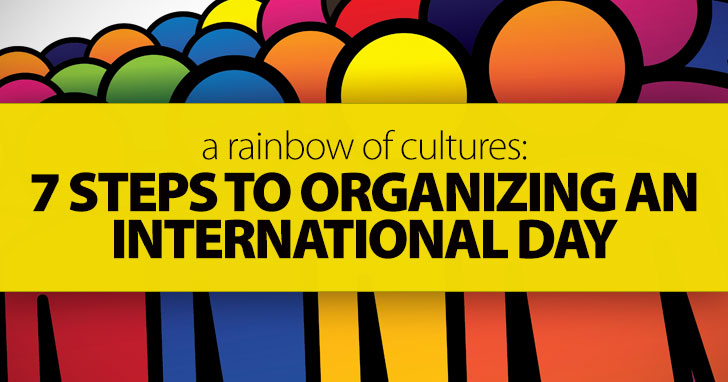
It’s a wonderful thing to celebrate the diversity of our ESL classes.
Often, our students are abroad for the first time, and have the experience of meeting people from continents and countries they might know little about. A way to enjoyably bridge these gaps is to organize an International Day which highlights the culture of each nation or ethnic group, enabling students to see past the differences and appreciate the similarities, and the colors, of each culture.

Organize an Unforgettable Cultural Experience for Your Students
-
1
Start Early
This will be a significant undertaking, so give yourself plenty of time – perhaps several months – to bring together ideas, distribute advice and instructions, and form your working groups. A good way to begin organizing is to consider how many rooms or locations you’ll need (one or two countries per room, for example) and how you’re going to allocate sufficient resources. Decide on a budget and how much you expect each country to contribute towards its own display.
-
2
Prepare Some Guidance
International Day will work best if your nation-teams work to a prepared plan. This short document should encourage the students to consider their own culture, and to tease out aspects which they believe the rest of the world needs to know more about, and/or would enjoy. Consider some or all of these:
- An exhibit on the country’s language(s) and ethnic group(s)
- A display of dance or music (the Turkish belly-dancing displays never fail to draw a crowd!)
- Examples of local food and drink
- Maps, globes and other graphics showing the location and appearance of the country
- A display about an important person from that country
- A display detailing an important historical event
- Information on an important national achievement – putting a man in space, hosting a major sporting event, achieving a significant world record, etc
-
3
Help With Organization
As part of setting up International Day, encourage the national groups to form a committee whose members have specific, realizable objectives. These might include sourcing and cooking food, arranging for embassies to send cultural material, engaging a musician or dancer, and organizing art works and displays. Encourage the teams to hold regular meetings with minutes and action points – this is good practice for the ‘real world’, in itself – and to hold each other accountable, in the spirit of working together as a team and trying not to let each other down. This is such a nice opportunity to show off some culture, and if well organized, it can be a truly memorable and enjoyable day.
-
4
Consider Your Visitors
How many students do you expect to be there? How will the students progress around the different displays? Should they follow a certain path or direction, e.g. clockwise? How can you predict and avoid traffic jams, or occasions when crowding will make things difficult to see or interact with? Play out the day on paper, and anticipate issues before they arise.
-
5
Make It Interactive
Many museums hand out quizzes or treasure hunts, and your International Day might benefit from something similar. Questions could be based on the displays and performances, and could include:
- Finding the meaning of a particular word in a foreign language
- Naming a type of dance, or food, or artwork
- Finding out about a historical figure
- Finding the country’s location, neighbors, major rivers, etc
Consider adding a guest book to each room, for visitors to write their thoughts. Encourage the students to consider interactive elements to their displays; this could include teaching visitors how to do origami, or dance the waltz, or use chopsticks, or sing a national anthem.
One other idea is to give nation-teams a ‘special mission’ specific to them. I sent the Saudi team in search of a recipe for kimchi, and ‘Team Holland’ on a mission to learn, and show me, how to mime like a French street artist. These missions could be rewarded with bonus points, or could just be for fun.
-
6
Be Positive
Our policy has been that there is no testing on International Day; the students are working on this purely to highlight their culture, and to enjoy themselves, so it would not be a good time for an exam! Praise your students as much as you like, leaving aside errors or problems, and focusing on their achievements in bringing to others the individuality of their background.
-
7
Prizes!
The only judging we permit is the giving of prizes. Students and/or teachers could vote on this at the end of the day. Prize categories could include:
- Best overall room
- Best performance
- Best food
- Most interesting display
- Best effort / diligence / the ‘Extra Mile’ award
- Most Interactive Team
Planning and carrying out an International Day can be a lot of work, but with a solid team, good management and planning, and enthusiasm, it has the potential to be a day your students will not forget, as well as a priceless opportunity to break down some cultural barriers.
We’ve found that, especially when it comes to food, such barriers can be remarkably easy to overcome, leading to lasting friendships and a more open, tolerant world-view.
P.S. If you enjoyed this article, please help spread it by clicking one of those sharing buttons below. And if you are interested in more, you should follow our Facebook page where we share more about creative, non-boring ways to teach English.







